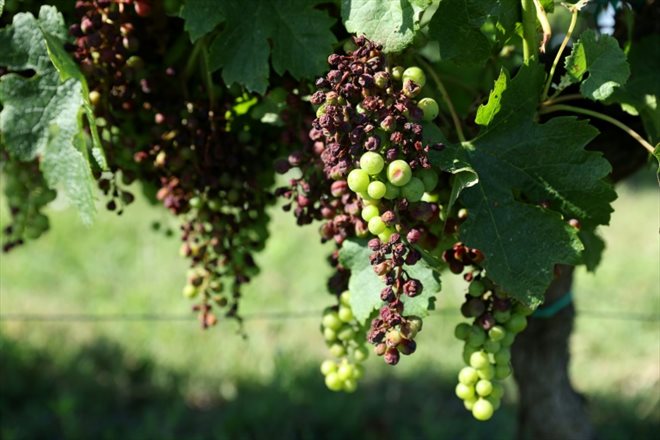While the harvest should last until the end of September, mildew, a parasite that is half-algae, half-fungus, has hit the vineyards of Nouvelle-Aquitaine hard with 90% of the vines affected to a greater or lesser extent (AFP /Archives/ROMAIN PERROCHEAU)
The first blows of secateurs were given this week by the Bordeaux winegrowers, who approach the 2023 harvest in full “disarray”, between overproduction and intense episode of mildew, but still want to believe in “a beautiful vintage”.
The harvest of grapes for Crémant de Bordeaux began on Wednesday in the first AOC vineyard in France with 110,000 hectares, even if the plots dedicated to sparkling wine represent only 1% of this area.
While the harvest should last until the end of September, mildew, a parasite that is half algae, half fungus, has hit the vineyards of Nouvelle-Aquitaine hard, with 90% of the vines affected on a more or less large scale depending on the chambers of agriculture in the region.
“It’s very hard for our winegrowers. When you have such tense situations and you come across an episode of mildew … Some have lost almost everything on their farm. The disarray is there”, explains to AFP Stéphane Gabard, president of the Syndicat des AOC Bordeaux and Bordeaux Supérieur.
It remains to be seen what the exact impact of mildew will be.
“Nobody knows: we thought at the beginning of June we would have a very big harvest, mid-July very weak, and there on the crémants it is rather better than what we thought”, comments Christophe Chateau, director of communication of the Interprofessional Council Bordeaux wine (CIVB).
“It is certain that with the mildew, a large part of the harvest is gone”, confirms Stéphane Gabard.
The latter considers plausible losses which would be between 20 and 50%, without wanting to advance on a definitive figure, because “it is heterogeneous according to the sectors, more or less broken down”.
“Fortunately, the mildew does not impact the quality of the grapes,” he notes, saying that the temperature conditions during the summer can portend “a good vintage”.
“Early vintages are often mature vintages. It’s rather good quality”, he judges.
Very tested, the Bordeaux vineyard is the subject of a plan to uproot the vines of 57 million euros co-financed by the State and the CIVB to regulate supply, restore prices and prevent the development of diseases in the vineyards. abandoned vines.
According to the pre-applications submitted in mid-July, nearly 10,000 hectares of vines should be uprooted after the harvest.
France also subsidizes the destruction of surplus red and rosé wines by distillation. The Bordeaux and Languedoc basins are the first applicants.
© 2023 AFP
Did you like this article ? Share it with your friends with the buttons below.




